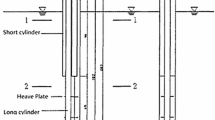Abstract
Korean Sewol is successfully lifted up with the strand jack system based on twin barges. During the salvage operation, two barges and Sewol encounter offshore environmental conditions of wave, current and wind. It is inevitable that the relative motions among the three bodies are coupled with the sling tensions, which may cause big dynamic loads for the lifting system. During the project engineering phase and the site operation, it is necessary to build up a simulation model that can precisely generate the coupled responses in order to define a suitable weather window and monitor risks for the salvage operation. A special method for calculating multibody coupled responses is introduced into Sewol salvage project. Each body’s hydrodynamic force and moment in multibody configuration is calculated in the way that one body is treated as freely moving in space, while other bodies are set as fixed globally. The hydrodynamic force and moment are then applied into a numerical simulation model with some calibration coefficients being inserted. These coefficients are calibrated with the model test results. The simulation model built up this way can predict coupled responses with the similar accuracy as the model test and full scale measurement, and particularly generate multibody shielding effects. Site measured responses and the responses only resulted from from the simulation keep project management simultaneously to judge risks of each salvage stage, which are important for success of Sewol salvage.
Similar content being viewed by others
References
Bureau Veritas, 2007. HydroStar for Experts User Manual, Research Department Bureau Veritas Press, France.
Chen, X.B., 2005. Hydrodynamic analysis for offshore LNG terminals, Proceedings of the 2nd Offshore Hydrodynamics Symposium, Rio de Janeiro, Brazil.
Jean-Robert, F., Naciri, M. and Chen, X.B., 2006. Hydrodynamics of two side-by-side vessels experiments and numerical simulations, Proceedings of the 16th International Offshore and Polar Engineering Conference, The International Society of Offshore and Polar Engineers, San Francisco, California, USA.
Lee, C.H. and Newman, J.N., 2004. Computation of wave effects using the panel method, in: Chakrabarti, S.K. (ed.), Numerical Models in Fluid Structure Interaction, WIT Press, Southampton.
WAMIT, Inc., 2015. Version 7.1 Wamit User Manual, USA.
Xu, X., Li, X., Yang, J.M. and Xiao, L.F., 2016. Hydrodynamic interactions of three barges in close proximity in a floatover installation, China Ocean Engineering, 30(3), 343–358.
Author information
Authors and Affiliations
Corresponding author
Additional information
Foundation item: This work was financially supported by the Korean ‘Sewol’ Salvage Project.
Rights and permissions
About this article
Cite this article
Yao, Z., Wang, Wp., Jiang, Y. et al. Coupled Responses of Sewol, Twin Barges and Slings During Salvage. China Ocean Eng 32, 226–235 (2018). https://doi.org/10.1007/s13344-018-0024-y
Received:
Revised:
Accepted:
Published:
Issue Date:
DOI: https://doi.org/10.1007/s13344-018-0024-y




